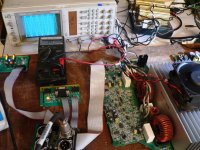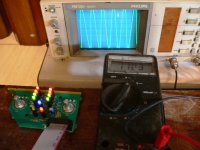Hello , i wont to build a replica of osc pl380 , power supply almost done (5kw continious ).
The problem is the price of the output mosfet
qsc pl380 uses IXFN80N50q2 , now i have find other mosfet that are not as robust as this one 80A at 500V , but i wont to paralel 2 of something much cheaper IXFK 48N60P,IXFK 64N50P,IXFL 100N50P,
The original gate drive used an 9A peak drive buffer , i wonna use something like 30A peak , for the 2 paralel mosfets (something like 50nf gate ) .
What do you think about this?
The problem is the price of the output mosfet
qsc pl380 uses IXFN80N50q2 , now i have find other mosfet that are not as robust as this one 80A at 500V , but i wont to paralel 2 of something much cheaper IXFK 48N60P,IXFK 64N50P,IXFL 100N50P,
The original gate drive used an 9A peak drive buffer , i wonna use something like 30A peak , for the 2 paralel mosfets (something like 50nf gate ) .
What do you think about this?
QSC
A poorly designed amplifier. Too many parts too much to go wrong. Power supply runs at 110KHz certainly a 5555ER core cannot do the power which QSC claim. Continuous power, no way. Pink noise not too much of a problem
The MOSFETs they use have a massive gate charge, If you must build this use lower gate charge MOSFETs such as STW20NM60 (600v 20a 60nc) and use 3+3 with their own gate drive ICs. (In order to discharge each gate drive at its own source). Fairchild FDA20N50 works as well
A poorly designed amplifier. Too many parts too much to go wrong. Power supply runs at 110KHz certainly a 5555ER core cannot do the power which QSC claim. Continuous power, no way. Pink noise not too much of a problem
The MOSFETs they use have a massive gate charge, If you must build this use lower gate charge MOSFETs such as STW20NM60 (600v 20a 60nc) and use 3+3 with their own gate drive ICs. (In order to discharge each gate drive at its own source). Fairchild FDA20N50 works as well
A poorly designed amplifier. Too many parts too much to go wrong. Power supply runs at 110KHz certainly a 5555ER core cannot do the power which QSC claim. Continuous power, no way. Pink noise not too much of a problem
The MOSFETs they use have a massive gate charge, If you must build this use lower gate charge MOSFETs such as STW20NM60 (600v 20a 60nc) and use 3+3 with their own gate drive ICs. (In order to discharge each gate drive at its own source). Fairchild FDA20N50 works as well
They dont claim 8kw sustained , at 4kw 3 of 10 burst are available , so 0.33 of that power is available let's say continious , that means 1.2KW per chanel or 2.4KW total ... a power that an E55 core can handle easy .
Regarding the mosfets i mentioned ,two of them in paralel each one with a 1-2 ohm gate rezistence and one 30A peak driver should be enought .
That's up to you, but the sound quality will suffer without some amount of feedback.No feedback?
EE5555 CORE
Dear Dexter,
An ETD59 core which is larger than an EE5555 core is rated at 2,500w at 100KHz. So how can the PL380 supply deliver the kinds of power claimed?
Pretty much all QSC's using the "power wave" SMPS use the same size transformer.
Go to Maginc and download their PDF showing power handling at various frequencies versus core type.
Dear Dexter,
An ETD59 core which is larger than an EE5555 core is rated at 2,500w at 100KHz. So how can the PL380 supply deliver the kinds of power claimed?
Pretty much all QSC's using the "power wave" SMPS use the same size transformer.
Go to Maginc and download their PDF showing power handling at various frequencies versus core type.
If is a good implementation, ETD59 core, can handle more than 4Kwatts continuous (well cooled)
Look here at 5200Watts.
Leco SMPS passing 5 Kw barrier.MOV - YouTube
Look here at 5200Watts.
Leco SMPS passing 5 Kw barrier.MOV - YouTube
Dear Dexter,
An ETD59 core which is larger than an EE5555 core is rated at 2,500w at 100KHz. So how can the PL380 supply deliver the kinds of power claimed?
Pretty much all QSC's using the "power wave" SMPS use the same size transformer.
Go to Maginc and download their PDF showing power handling at various frequencies versus core type.
The E55 can handle 5KW for continuous duty , it's used in Telecomunication power supply , but it cooled by forced air and it has cooper heatsink (around the entire core and bobbin ), for an amplifier that runs with audio signal , (the smps handle small burst of peak power for short period of time) e55 or etd59 can be used for 5kw cooled just by forced air without heatsink.
Now regarding the output mosfet , what should i use ? What parameters of mosfet are critical for class D ?
I'm thinking at Qg, Coss , Qrr .
I know that for a fast mosfet , Qrr has to be small , at the same time to switch a mosfet fast enough the Qg has to be small or to use a more powerful gate drive buffer (there is the internal gate resistance of the mosfet that will limit the amps more , so the mosfet must have Qg << ) , and to decrease the power loss by switching the Coss <<.
I have propose 2 mosfet in the first or second post , are those good ? BTW i need to switch more than 60A .... that's why i'm thinking at 2 in paralel ....
The E55 can handle 5KW for continuous duty , it's used in Telecomunication power supply , but it cooled by forced air and it has cooper heatsink (around the entire core and bobbin ), for an amplifier that runs with audio signal , (the smps handle small burst of peak power for short period of time) e55 or etd59 can be used for 5kw cooled just by forced air without heatsink.
Now regarding the output mosfet , what should i use ? What parameters of mosfet are critical for class D ?
I'm thinking at Qg, Coss , Qrr .
I know that for a fast mosfet , Qrr has to be small , at the same time to switch a mosfet fast enough the Qg has to be small or to use a more powerful gate drive buffer (there is the internal gate resistance of the mosfet that will limit the amps more , so the mosfet must have Qg << ) , and to decrease the power loss by switching the Coss <<.
I have propose 2 mosfet in the first or second post , are those good ? BTW i need to switch more than 60A .... that's why i'm thinking at 2 in paralel ....
With 1 MOSFET switching 60A "fast" (depending on just how "fast"..) you might get into trouble with package lead inductance, unless you're using a low inductance package (and PCB design).
Paralleling up FETS also reduces the total inductance, which helps a lot especially in "normal" packages like TO220 or TO247.
Well you say 5Kw continuous, well at what frequency?
I guess Magnetics no nothing about the cores they make!!!
The You Tube video shows zero.
We monitor core saturation and the figures which Magnetics publish are in line with what we measure
I think this post is for DjLeco please quote the post that you refer .....
Just some link's with E65 core at 5kw continiuos :
http://www.pes.ee.ethz.ch/uploads/tx_ethpublications/biela_DCDC_INTELEC07.pdf
And here is one with 11 Kw and 5stack of e85 core ... there is a publication of 10KW power supply with 2 transformers made from e55 core ....
The FS is something around 100Khz and 120Khz (at the transformer), no need for something bigger, because the core losses increase and the magnetic components don't decrease as you think ...
- Status
- This old topic is closed. If you want to reopen this topic, contact a moderator using the "Report Post" button.
- Home
- Amplifiers
- Class D
- QSC PL380

